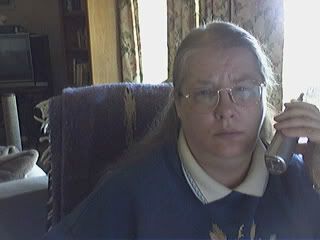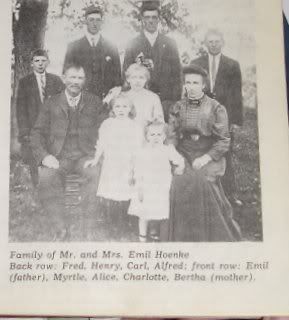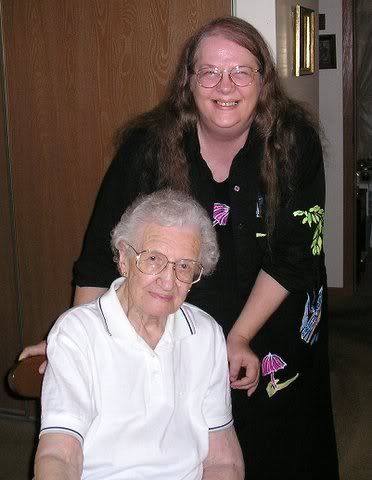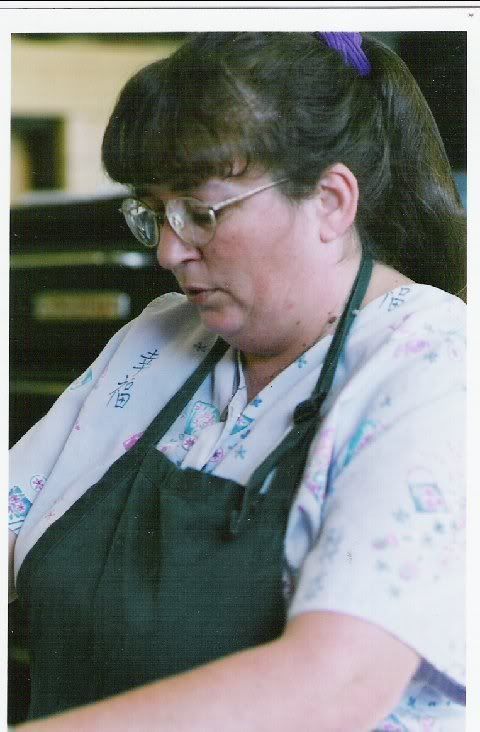A Report Recommendation
Personally-based Human Resource Report - Sr. TessOctober 16, 2006
Notation #1: I am back on schedule and have written the first report of the day. It is a short couple page report on our human resources. This second report is a longer personally-based human resource report that primarily covers the positions of The Intern and myself. I am going to complete another longer report today on business improvement - strategy. That will combine what we are going to consider communication issues and address things like CARF, QHSPs, committees, reports, case reviews, and policies and procedures as noted during the administration meetings. The last report from information from the admin meetings will include safety and attitude (surveys and such), but I have to include with that information from the incident reports, which I can do when I come in tomorrow.
Notation #2: Just as a reminder, we have two staffings on Wednesday at 9 am and 10:30 am and one on Friday at 10 am. This last couple of weeks, we've initiated The Intern to be working the goals part of the annuals. This was one of the last things to learn about annuals and the most difficult. She still needs a good amount of supervision and confidence building with goals, but fundamentally she's got everything it takes to do it well. I would like her to handle the last 4-5 meetings this year Nov/Dec on her own with me as her silent partner. By this I mean that she should be able to facilitate the annual meeting along with all other chores in preparation for the meeting. At that time, she will learn the last annual skill of writing up the final Annual Report. Now, she does the information that repeats from one report to another now, but there are 3 paragraphs that are paraphrases of things that happened during the meeting. She should be doing that as well. Last week we handed over to her to do independently the scheduling of the necessary meetings in preparation of the annual and the project of scheduling her own time to complete all annual tasks.
Notation #3: In addition, we've handed to her the work of updating the client files. We had outlined what has to be received and given her the notes as to where we are in dealing with each family. The Intern still needs assistance to make sure all the bases are being covered, but that will come in time as she develops more closely her own systems. She doesn't have at this point the spirit that will push her into being more assertive in obtaining paperwork from difficult families. Again, this too will come as she realizes deadlines. The Intern is caught up with our caseload as to Qnotes, or at least half way through with this month's notes. She'll need only a day or two to finish them. I would like to see her finishing up this year with the annual work. She will have gotten through our caseload, which I believe to be now 23 with possibly one more coming in.
Sister Tess, If I could make a recommendation I feel strongly about ... Please let us work it out so that The Intern can have my entire caseload. She is ready and able to take it on AND still spend the next 6 months learning about the groups and individual goals of and with the clients. This is in addition to assisting the other Q once a week with the other Q’s goals. Between you and me, the Intern has mentioned separating her work from the other Q’s because The other Q is still behind in Qnotes, though, the other Q has taken my suggestion and given The Intern complete responsibility for her clients’ Qnotes (goal management) over the last few months, which is making that system more efficient. If the Intern is not able to keep time with The other Q’s Qnotes, it is because the other Q has taken her off-task to do other annual work, write business letters, complete ICAPs, or do the other Q’s filing, or because the other Q has not written the goal data sheet out for the DSP to be making notes on. I’m fairly certain you know all of this and that there is still a large batch of the other Q’s Qnotes that have been completed only from The Intern’s half, and that have not been finished from the other Q’s half.
The Intern would be able to take on our caseload within four days per week allotment of time in that the case load is in very good condition. Together we have gone through the entire caseload annual reports from July through December and won’t need to handle another cycle of annual meetings from Christmas until July next year. To take on the caseload at this point would mean completing Qnotes in basically 3-4 days a month, and sending out document requests for the case files, or calling families for them 3-4 days a month. I've been assuring that The Intern has been talking with the parents as small problems come up and I've been training her in taking care of clients problems in that she's listened as I've handled problems (working right next door) and worked closely with my Q Chrononotes (which establishes the logic of what we are doing with each client). After each issue has been addressed of a client problem ... we take a hard copy note that summarizes the issue and it is added to an ongoing client record; the Q Chrononote. In fact, it is because the other Q had noted from memory a paragraph or so of events to her Qnotes instead of a separate Q Chrononote, that she is behind in her Qnotes. Without this notation added to the other Q’s Qnotes, The Intern is able to complete them independent of The other Q’s memory.
The act of completing annuals, Qnotes, Q Chrononotes, and case files – is in affect having taken over an entire caseload and we believe sincerely that The Intern can take on this series of tasks. Because the Intern’s schedule is relatively clear for the time period after Christmas to July, she has time to be assistive with goals and spending time with learning to relate to clients individually and in groups. There is not a lot of discipline work to be done. We’ve maintained most discipline with this caseload by establishing up front communication of issues as they develop. At least that has always been the goal of providing for our client base. We’ve followed your directive in trying to spend no more than ten minutes with each client per problem. I can maintain “supervision” of the Intern and her caseload until after the state inspection and she’s officially been made a Q by the State. I should send in that paperwork this week.
I believe giving The Intern complete control of a regular sized caseload is going to be critical in keeping her. I know from talking to her, The Intern is still interested in field work. One of the things she’ll want is her own caseload. The Intern mentioned last week that she was considering referring a social work friend of hers to CSO as an ISSA and she was also interested in becoming an ISSA herself. Somewhere within the intern, she believes she could be capable of a 75 client caseload and that is alluring to her, because she knows she is as smart and likely more fresh and energetic than the ISSAs she’s seen as well as being able to offer the Spanish language and knowledge of its culture.
I see the formula for working for the state as an ISSA to be very simple in that they meet with the individual 4 times a year at the providers’ or home locations for general follow-up and an occasionally you need to resolve a problem, and then you submit summary and billing forms. That’s pretty much the entire job. The hard part is that you have to repeat that for a large caseload of 75 people and the job takes organizational efficiency with pressure coming from providers and families who are not appreciative of your business needs or schedules. And, you have to put-up with the political scramble of up 30-35 tired co-workers sharing the same limited resources or of the affect of being poorly managed by ill-trained supervisors and a central ineffective/inefficient general administrator.
I think The Intern is looking for the competitive challenge, responsibility, and she is enticed by the "excitement" of handling big problems that a social worker might, particularly those due to mental illness and abuses (drug, alcohol, sexual, crime, and homelessness) of those with mild mental retardation. I think she is young and idealistic, not yet weary of safety and security issues that she’ll need to face, or in respect, she’ll need to learn the impact of an overwhelming workload that can be emotionally turbulent to one’s balance. I don’t believe she sees the group of individuals at St. Rose as being particularly needy, needy of her, or in general challenging.
The Intern is not going to get at St. Rose the kind of excitement she thinks she wants out in the community. But, she can get from St. Rose how to relate to people in a constructive manner, especially through learning goal processes from presenting needs. For this to happen, I believe St. Rose Center has to make a forward step in formalized processes, which is an area I’d like to spend more time developing. I see The Intern- like the other Q - strongly leaning toward social work not psychology; at least it is The Intern’s stated preference and The other Q’s training. I see social work as mostly connecting people to services offered by others and then checking on the people and service to assure they are filling the individuals’ needs; all services contain their own provisional advantages and limitations as does the service St. Rose offers. I would like to focus mainly on the service we are offering.
I see a need for social work in society and St. Rose Center, but it is never going to be my preference. I am orientated toward educational psychology and systems, not social work. Over the last 7 years I have taken care of the social work aspects of a case load, but it falls short of fulfilling my ambition. I have always been more interested in how the mind and other systems work to facilitate positive personal learning (change). It is part of the reason I take such great care in goal making and why I’ve always enjoyed the systems-style organization and management CARF presents. The particular stronghold of CARF is in defining avenues of business and program growth/wealth. If I were to not be worrying directly over a caseload, I would be able to focus on the center’s performance. We believe we should be very specific in defining a structure from what is already now in place. It would be relatively easy and straight forward to build from it.
For example, we had shown in a previous report that according to a given set of calculations the average cost of program service per client month is $835, which we then divided only theoretically by the five domains, which would then show an average monthly cost of $167 per domain each month. The costs include income from IDHS, donations, grants and others. Expenses include building, business, staff, and Program. Program factors included were:
The Achievement Domain - Physical Fitness, motor skills and enrichment
The Social Domain - Social responsibility and language
The Personal Domain - H/S/S, personal responsibility, read/write
The Community Domain - Community, work readiness, math/money
The Living Domain - Self help and life skills
Effect factors similar to program factors, change each month and include QHSP progress notes, annual goals, behavior/human rights report, incident reports, individual's satisfaction survey, outings, events, and DSP observations.
The base ICAP Score is an assessment of the individuals’ growth and is fixed annually; it includes Adaptive behavior that is motor skills, social/communication skills, personal skills, community living skills and broad independence skills, which very closely mimic our domains stated above. The ICAP also includes maladaptive behavior that is internalized, asocial, or externalized.
The annual individual program plan (IPP) score is also fixed annually; it includes preferences, abilities, strengths, needs, support services now used and not used but may be needed, family/social/leisure, limiting factors, needs and limitations, service needs, integration needs, self-advocacy, service options.
Each of these variables taken collectively and comprehensively, show a system of program organization that can project goals, objectives, and outcomes that are measurable by adding series of positive or negative valences – one at a time. As we had shown earlier one of my goals would be to execute a Performance Analysis report with its goal being to show quarterly that 25% of the individuals average a domain increase of 5% per month and an overall positive program efficiency rating of 10% or better (per average domain cost of $167) by multiplying the annual IPP and ICAP scores to form a new numerical annual base rate and calculating against that the program effect factor.
This hasn’t been done before by any agency, I am sure. The prime reason I would want to do something like this is to better establish a training program specific to needs of the individuals and to assist staff in their training efforts. For example, again using Fred, I would like to meet with the DSP after looking over his program and say to her something like:
Fred started with an annual base score of 9.08, which was a 35% decrease over his average base score. This quarter Fred only showed a total program affect increase of 2% in the social domain, which was lower than the 3% gain we had been hoping for. We know that Fred is welcoming when others greet him and communicates when asked to in large groups such as Town Hall and the Thinking Group. Fred wants to practice more leadership skills. He wants to listen to others, develop peer relationships, and be more assistive. Fred has difficulty expressing his interest to others, although he wrote more expressively in his newsletter goal this quarter and he appears to be asking more questions. Fred is unsure how to conduct some relationships and needs to be taking more initiative in general. For example, at work Fred lacked professionalism when he talked socially with his peers while on the clock. Fred is more appropriate when visiting with friends and neighbors.
Recommendation #1: Fred would be showing leadership if he could learn to listen to non-verbal cues, such as a talkative peer at work might be signaling he’s having trouble focusing on work tasks. #2: He could develop a better peer relationship telling his peer he had to keep working, but then initiate the social concern when on break. #3: Fred could be given practice asking people if they need help in particular group settings, and #4: and he could be presenting his newsletter column to his peers and ask them for feedback.
This conversation would be very assistive to helping the DSP focus, have covered for the quarter all relevant grounds (significant notations on the performance report), and in general have progressed Fred’s social domain toward the next set of specific learning events. While the DSP could have thought these ideas herself, she didn’t appear to have done so without assistance. Given time and opportunity to review the client’s performance, it is possible to advance the general program affect, do so methodically without losing the personal affect of the center’s reporting policies, and can be shown in outcome form. Such as:
Outcome #1: Learn 3 non-verbal cues such as a) a co-worker is talking socially during work time, b) a customer grabs a bag out of the bagger’s hand, c) the boss gives you two orders to do something before he says hello; #2: Initiate a social conversation in the lunch room at work, and relay it to the DSP; #3: Start a log noting things you help people do; and 4) Share a newsletter entry and ask for feedback.
I would like to work full-time integrating CARF into daily planning, so that the center could one day teach others as an effective and efficient business and program model. I would work to record business systems and improve the program standards as a full-time opportunity.
At this time under your care, the business runs very efficiently, but it’s still within you. I’ve lost ground from the days I used to understand the business better by being at your right elbow. I feel I could better collect information and flag areas that would make us very proficient in the field if it were a recognizable task. My model of course would be the CARF standards and it would be done in real time and effort. As the business stands – its analysis is taking place in your mind as decisions are quickly made. I don’t see that as changing, but I see ourselves as drawing summaries or pulling together patterns of bulk information to submit for administrative team analyzation. Goals would be set, performed and then evaluated. I would contribute information back into the system through my writing the affect of the business to all involved.
I would like to use the performance reports as a staple of our new responsibilities in directing the program itself. I would like to pool the suggestions we would be making to the DSPs as listed above in a formal learning program, so that the resource of one might be useful to each of the staff. I would like to study the center as if I were writing its story. The program itself has a structure that is sound when considering the different program areas as topics, but at this time the topics are run only as well as the DSP chooses per daily energy and complications the clients bring in. Only some of the DSPs even discuss “their” program, such as the intent of a social skills exercise, or the result of a client spreading jam. Even when the individual works or goes out on an outing, very little is recorded as to the affect this portion of the program has on the individual. At this time, we can only see a happy face, or read a satisfied monthly report. It should be that these things continue to be recorded, but they should be taken in account with other aspects affecting the client. Right now a DSP might repeat aimlessly seven different times, in five different ways that so-and-so “likes his community job.” Ok, and what then? Why does he like it? What does he like about it? Does he like it all the time? How does he communicate this to his peers? And, what is it teaching him about life? Did he learn to improve a goal, or is he just showing up?
These are the kind of questions that could be asked and answered to give our program better depth and value. I believe I can improve the program greatly, by just paying attention to how the business is unfolding and in developing real thought into what people are doing in the program. It is too easy to say 9106 community outing and let things go at that. I am interested in learning how the community outings play an actual affect on the individual; what makes the experience meaningful, could another agency like ours repeat with the same affect. What variables made it a worthwhile outing? Has the individual’s perspective changed? I want to bring forward conscientious awareness of what we are or could be doing. It is at that point we will learn to generalize making good choices as educators for the right reasons and learning outcomes.
















